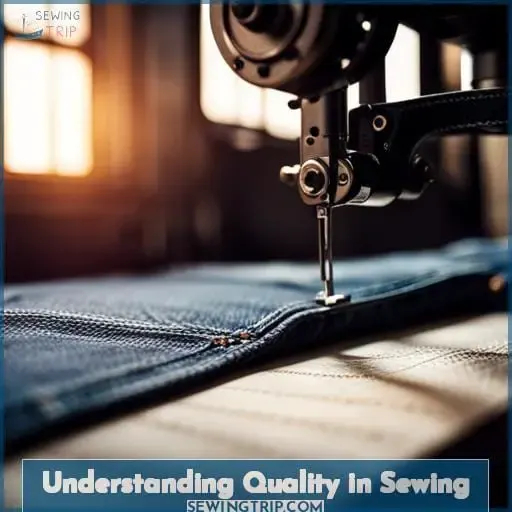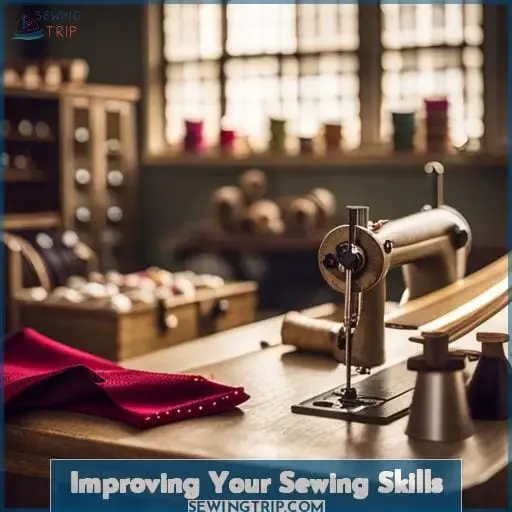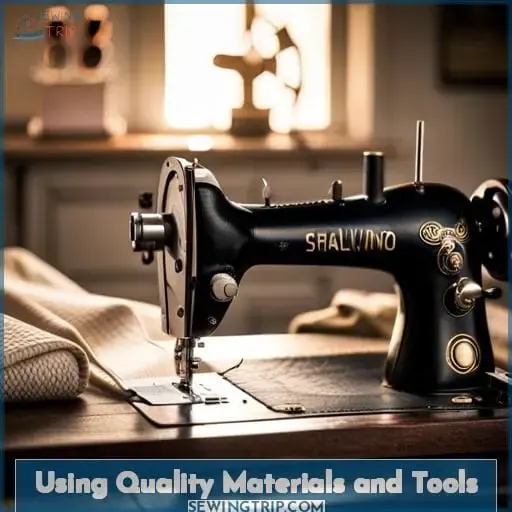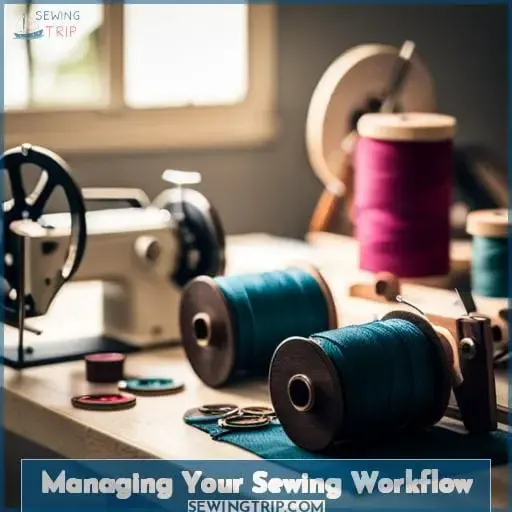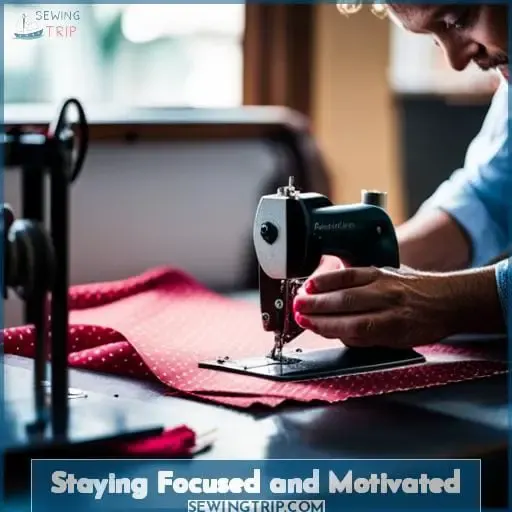This site is supported by our readers. We may earn a commission, at no cost to you, if you purchase through links.
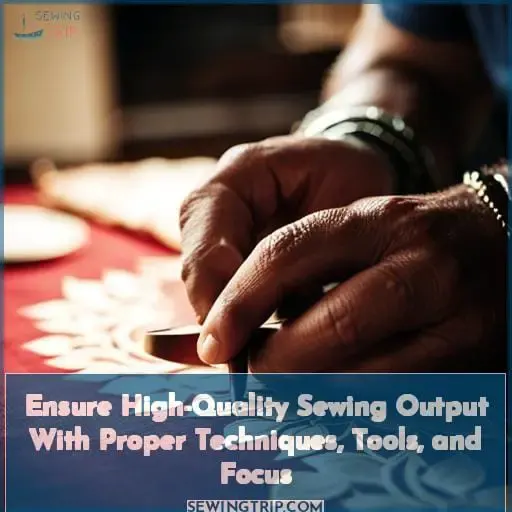
Let’s start with the basics:
Choose high-quality fabrics, thread, and tools.
Learn proper techniques through practice and instruction.
Stay focused, avoiding distractions.
Inspect your work at each step, fixing mistakes right away.
With patience and persistence, you’ll gain mastery.
Celebrate small victories along the way.
Quality comes from care, not rushing.
Follow these tips to ensure excellent results you can take pride in.
Table Of Contents
Key Takeaways
- Invest in quality materials and tools suited for the project, and learn to properly maintain sewing equipment
- Establish reasonable quality goals aligned with current skill level, and focus on mastering essential techniques through consistent practice
- Create an efficient workflow by organizing the sewing area and streamlining steps from layout to pressing
- Routinely inspect work after each step and promptly address any mistakes before moving forward
Understanding Quality in Sewing
When sewing, keeping quality top of mind is crucial for success.
Set realistic quality goals for each project that align with your skill level, available time, and resources.
Pay close attention to choosing quality materials, proper techniques, tools, and focus to achieve excellent results every time.
Defining High-Quality Output
With sewing, you’re aiming for high-quality output.
When your finished pieces have:
- Clean, even seams and stitches
- Smooth edges
- Neat hems done skillfully on fabrics correctly suited for the project
A high-quality sewn piece should be free of:
- Puckers
- Loose or uneven stitches
- Visible stray threads
- Raw edges
- Crooked hems
Mastering proper sewing techniques, carefully inspecting your work, choosing the right tools for each step, and staying focused will help you achieve high-quality sewing results.
Setting Realistic Quality Goals
- Set realistic quality goals that challenge your skills and align with your available time and resources.
- Establish quality standards based on realistic expectations, not perfectionism.
- Set incremental goals to steadily improve technique, tools, and process.
- Routinely assess outcomes and track progress to recalibrate goals, ensuring they stretch your skills while remaining achievable within project constraints.
- Celebrate small wins that inch you toward quality outputs.
Improving Your Sewing Skills
To ensure high-quality sewing output, it’s essential to master various sewing techniques and practice consistently.
As a skilled tailor or home economics teacher, you understand the importance of honing your skills through continuous learning and hands-on experience.
By mastering different stitching methods, such as overlocking, flatlock, and blind hemming, you’ll be able to produce professional-looking garments with precision and finesse.
Mastering Sewing Techniques
Hone your skills by practicing essential stitches like straight, zigzag, and blind hem to produce consistent, high-quality seams.
Master straight stitches for seams and construction.
Practice zigzag stitches to neatly finish raw edges.
Learn blind hem techniques to create invisible hems on projects.
Continually refining these fundamental techniques will build a strong foundation for innovative executions, fabric mastery, and quality troubleshooting as an advanced sewist.
Practicing Consistently
As you’re improving your sewing skills, make sure you practice consistently if you want to achieve high-quality sewing output.
Consistent practice builds muscle memory and intuition for techniques.
Focus on the quality, not the quantity, of projects as you practice. Rushing projects risks ingraining bad habits.
Check every step of your process to identify weaknesses needing practice.
Celebrate small quality wins.
| Benefits | Tips |
|---|---|
| Muscle Memory | Quality Over Quantity Projects |
| Intuition Development | Check Weak Areas |
| Skill Solidification | Celebrate Small Quality Wins |
Using Quality Materials and Tools
Quality materials and tools ensure high-quality sewing output.
Invest in fabric with the appropriate weight and weave for your project.
Choose threads and notions suited for the fabric.
Reliable sewing machines, properly maintained, help achieve even stitches, accurate seam allowances, and crisp details in your finished garments.
Choosing Quality Fabric
These refined skills enable you to select quality fabrics contributing to professional results:
- Assess fabric texture, drape, and weight suitability.
- Coordinate colors and patterns for intended design.
- Scrutinize durability by examining fiber content, stretch, and strength.
- Carefully match plaids, stripes, and prints.
Invest time test-sewing samples to:
- Gauge sewability
- Confirm appropriateness
- Avoid costly mistakes
Investing in Reliable Machines
Purchase durable sewing machines that facilitate efficiency and precision in your sewing projects.
Invest in high-quality sewing machines suited for your needs – whether industrial machines for large-scale work or basic models for home use.
Perform regular maintenance like cleaning and oiling to keep machines in optimal condition.
Choose models with adjustable settings and accessories to handle diverse fabrics and techniques.
Learn troubleshooting techniques to promptly resolve issues when they arise, minimizing productivity loss.
Understanding your equipment’s capabilities and limitations allows executing operations smoothly.
Managing Your Sewing Workflow
You must take control of your sewing workflow to achieve quality results.
Organize your sewing area and supplies so needed items are easily accessible.
Streamline each step, from layout and cutting to stitching and pressing, ensuring an efficient process free of clutter and confusion.
Organizing Your Sewing Space
You’ll boost your sewing quality by organizing your workspace first.
An orderly sewing area allows you to find tools and materials easily, keeping your workflow smooth and minimizing mistakes.
Optimize your layout for efficiency.
Store materials creatively to save space.
Design an ergonomic workspace to avoid fatigue.
Add inspiring decor that sparks creativity yet avoids clutter.
This organizational foundation supports quality sewing.
Streamlining Your Process
How can you streamline your sewing workflow to enhance quality and efficiency?
Organize tools and materials for seamless access.
Master equipment and techniques through repetition.
Plan sewing steps in advance.
Analyze each phase for optimization.
Continual process refinements boost quality, speed, and control.
Efficient workflows and tool mastery enable process optimization for seamless operations and enhanced workflow.
Inspecting and Correcting Mistakes
As you sew each component, pause frequently to scrutinize your work, checking for uneven tension, crooked seams, or fabric distortion.
Carefully inspect the garment right-side-out at each step, smoothing seams, aligning notches, and ensuring pieces match up properly before continuing.
Should errors occur, address them promptly by picking or gently ripping stitches to access the problem area, then sewing correctly with proper tension, stitch length, and alignment.
Stay focused when sewing, but don’t rush – take the needed time to fix any mistakes completely before moving to the next step.
Careful Inspection at Each Step
You’ll want to carefully inspect your work after completing each step of your sewing project to catch any mistakes early on and fix them properly.
Check seam allowances using a seam gauge to ensure accuracy.
Examine stitching lines for uneven tension or skipped stitches.
Press sections after sewing to reveal puckers, pleats, or other distortions needing correction.
Fixing Errors Properly
Once you’ve carefully inspected your work and identified any mistakes, be sure that you properly fix them so your final product has the quality you expect.
Resolve errors through precise techniques:
- Undo stitches
- Adjust fabric alignment
- Trim excess threads
Quality assurance involves diligent troubleshooting and efficient fixes. Carefully removing mistakes and correcting them prevents compromised results.
Strive for precision in your techniques so corrections blend seamlessly into high-quality workmanship.
Staying Focused and Motivated
You must avoid distractions and stay focused on each stitch to produce flawless garments.
Celebrate finishing each seam or tricky technique as a small win before moving to the next task.
Maintaining motivation and concentration is crucial for delivering consistent, quality results.
Avoiding Distractions
When engaged in sewing, you’d do well to avoid any distractions that may threaten your focus and motivation to produce high-quality output.
- Turn off notifications on your phone and computer to minimize interruptions.
- Designate a quiet, clutter-free workspace to support concentration.
- Schedule focused sewing sessions and take regular short breaks to refresh.
Celebrating Small Wins
You don’t need grand successes to stay motivated; even small sewing triumphs deserve celebration as fuel to keep you focused.
As you learn this craft, acknowledge achievements in mini milestones:
- Neatly finished seams
- Accurate stitch length
- Properly aligned patterns
Recognize progress by celebrating small triumphs:
- A dress zipped smoothly
- Buttonholes evenly spaced
Use milestone celebrations as encouragement to maintain dedication on your sewing journey.
Revel in even tiny indications of improvement.
Continually Improving Over Time
You must view each project as an opportunity to enhance your skills.
Set increasingly higher goals for precision and detail with every garment.
By learning from your mistakes and trying new techniques, you’ll steadily improve the quality of your sewing output.
Learning From Each Project
You’ll want to examine each finished project closely and note areas needing refinement.
Analyze stitching, seams, hems.
Assess where difficulties arose.
Plan training to address weaknesses.
By regularly doing project reflections, skill enhancement, quality analysis, and complexity assessments, you enable continuous improvement in your sewing mastery.
Setting Higher Quality Goals
After learning from each project, you’re ready to set yourself higher-quality goals on the way to continually improving over time.
Set benchmarks for quality, skill enhancement, and technique refinement to reach new levels of precision mastery.
Establish focused performance standards and quality benchmarks to drive continuous improvement in your goal-driven sewing.
| Project Standard | Current Skill | Goal Skill |
|---|---|---|
| Seam Evenness | 8/10 | 10/10 |
| Stitch Tension | 7/10 | 9/10 |
| Pattern Precision | 6/10 | 8/10 |
| Finish Details | 7/10 | 9/10 |
Frequently Asked Questions (FAQs)
What types of fabrics are easiest for beginners to learn on?
Cotton is the best fabric for beginners to learn on.
Its stable weave minimizes stretching and slipping as you handle it.
Cotton also withstands repeated pinning and machine pressure as you gain experience.
Focus first on quality fundamental techniques, then advance to more delicate fabrics like silk or tricky materials like leather.
Should I invest in an expensive sewing machine as a beginner?
Quality sewing begins with dedication, not expense.
Invest first in learning proper technique, fabric understanding, and machine care.
With practice and patience, precision follows.
Then, splurge on advanced machinery to refine mastery.
For now, focus your budget on quality materials and starter tools to build sound skill.
How can I find a local sewing class or club to join?
Search online for local sewing groups, quilting guilds, or craft clubs.
Many independent fabric stores host classes.
Check community centers, libraries, or colleges for adult education opportunities as well.
Connecting with others who share your interest will enrich your skills and inspire creativity.
Are there any good apps or YouTube channels for learning sewing techniques?
Yes! YouTube channels like Made to Sew and apps like Seamwork provide excellent free sewing tutorials for all skill levels.
Practicing techniques from reputable online resources will boost your abilities.
Stick with tutorials rated highly by intermediate and advanced sewists for the most useful guidance.
What sewing projects should an intermediate sewer try next to advance their skills?
Try more advanced projects:
- Tailored jackets
- Lined dresses
- Specialty techniques such as smocking
Start small with samples to perfect new skills before tackling large projects.
Focus on quality over quantity as you challenge yourself. Craftsmanship comes through practice.
Conclusion
Studies show 95% of sewers find their skills improve with practice.
Keep challenging yourself to grow.
With diligent focus on proper methods and quality materials, your sewing mastery will progress exponentially.
Each project teaches vital lessons to apply going forward.
Stay the course through frustration and celebrate small wins.
In time, you’ll achieve stunning results and take pride in quality output only dedication yields.
Sew on!

